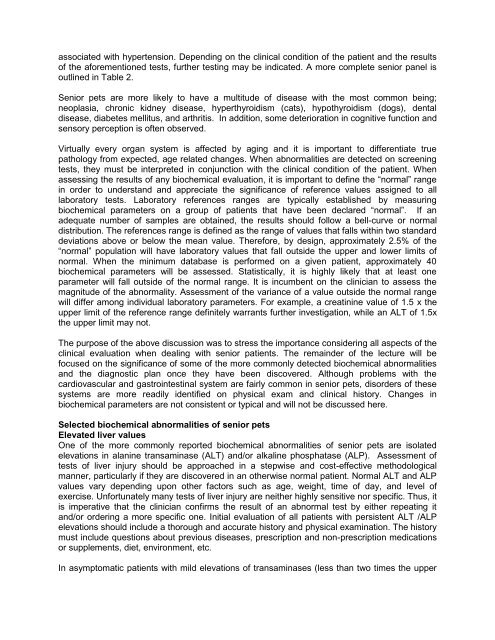Screening and Management Considerations for the Geriatric Dog ...
Screening and Management Considerations for the Geriatric Dog ...
Screening and Management Considerations for the Geriatric Dog ...
You also want an ePaper? Increase the reach of your titles
YUMPU automatically turns print PDFs into web optimized ePapers that Google loves.
associated with hypertension. Depending on <strong>the</strong> clinical condition of <strong>the</strong> patient <strong>and</strong> <strong>the</strong> results<br />
of <strong>the</strong> a<strong>for</strong>ementioned tests, fur<strong>the</strong>r testing may be indicated. A more complete senior panel is<br />
outlined in Table 2.<br />
Senior pets are more likely to have a multitude of disease with <strong>the</strong> most common being;<br />
neoplasia, chronic kidney disease, hyperthyroidism (cats), hypothyroidism (dogs), dental<br />
disease, diabetes mellitus, <strong>and</strong> arthritis. In addition, some deterioration in cognitive function <strong>and</strong><br />
sensory perception is often observed.<br />
Virtually every organ system is affected by aging <strong>and</strong> it is important to differentiate true<br />
pathology from expected, age related changes. When abnormalities are detected on screening<br />
tests, <strong>the</strong>y must be interpreted in conjunction with <strong>the</strong> clinical condition of <strong>the</strong> patient. When<br />
assessing <strong>the</strong> results of any biochemical evaluation, it is important to define <strong>the</strong> “normal” range<br />
in order to underst<strong>and</strong> <strong>and</strong> appreciate <strong>the</strong> significance of reference values assigned to all<br />
laboratory tests. Laboratory references ranges are typically established by measuring<br />
biochemical parameters on a group of patients that have been declared “normal”. If an<br />
adequate number of samples are obtained, <strong>the</strong> results should follow a bell-curve or normal<br />
distribution. The references range is defined as <strong>the</strong> range of values that falls within two st<strong>and</strong>ard<br />
deviations above or below <strong>the</strong> mean value. There<strong>for</strong>e, by design, approximately 2.5% of <strong>the</strong><br />
“normal” population will have laboratory values that fall outside <strong>the</strong> upper <strong>and</strong> lower limits of<br />
normal. When <strong>the</strong> minimum database is per<strong>for</strong>med on a given patient, approximately 40<br />
biochemical parameters will be assessed. Statistically, it is highly likely that at least one<br />
parameter will fall outside of <strong>the</strong> normal range. It is incumbent on <strong>the</strong> clinician to assess <strong>the</strong><br />
magnitude of <strong>the</strong> abnormality. Assessment of <strong>the</strong> variance of a value outside <strong>the</strong> normal range<br />
will differ among individual laboratory parameters. For example, a creatinine value of 1.5 x <strong>the</strong><br />
upper limit of <strong>the</strong> reference range definitely warrants fur<strong>the</strong>r investigation, while an ALT of 1.5x<br />
<strong>the</strong> upper limit may not.<br />
The purpose of <strong>the</strong> above discussion was to stress <strong>the</strong> importance considering all aspects of <strong>the</strong><br />
clinical evaluation when dealing with senior patients. The remainder of <strong>the</strong> lecture will be<br />
focused on <strong>the</strong> significance of some of <strong>the</strong> more commonly detected biochemical abnormalities<br />
<strong>and</strong> <strong>the</strong> diagnostic plan once <strong>the</strong>y have been discovered. Although problems with <strong>the</strong><br />
cardiovascular <strong>and</strong> gastrointestinal system are fairly common in senior pets, disorders of <strong>the</strong>se<br />
systems are more readily identified on physical exam <strong>and</strong> clinical history. Changes in<br />
biochemical parameters are not consistent or typical <strong>and</strong> will not be discussed here.<br />
Selected biochemical abnormalities of senior pets<br />
Elevated liver values<br />
One of <strong>the</strong> more commonly reported biochemical abnormalities of senior pets are isolated<br />
elevations in alanine transaminase (ALT) <strong>and</strong>/or alkaline phosphatase (ALP). Assessment of<br />
tests of liver injury should be approached in a stepwise <strong>and</strong> cost-effective methodological<br />
manner, particularly if <strong>the</strong>y are discovered in an o<strong>the</strong>rwise normal patient. Normal ALT <strong>and</strong> ALP<br />
values vary depending upon o<strong>the</strong>r factors such as age, weight, time of day, <strong>and</strong> level of<br />
exercise. Un<strong>for</strong>tunately many tests of liver injury are nei<strong>the</strong>r highly sensitive nor specific. Thus, it<br />
is imperative that <strong>the</strong> clinician confirms <strong>the</strong> result of an abnormal test by ei<strong>the</strong>r repeating it<br />
<strong>and</strong>/or ordering a more specific one. Initial evaluation of all patients with persistent ALT /ALP<br />
elevations should include a thorough <strong>and</strong> accurate history <strong>and</strong> physical examination. The history<br />
must include questions about previous diseases, prescription <strong>and</strong> non-prescription medications<br />
or supplements, diet, environment, etc.<br />
In asymptomatic patients with mild elevations of transaminases (less than two times <strong>the</strong> upper

















